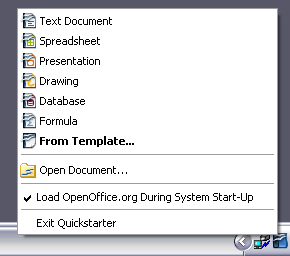Запуск Writer
Если вы читаете этот текст в OpenOffice.org, то уже знаете как запускать Writer. Если же вы читаете распечатанный текст или видите его на экране в формате PDF, то возможно, что вы это ещё не умеете делать. Познакомимся с тремя способами запуска:
- из системного меню
- из существующего документа
- из командной строки
Запуск из системного меню
Самым распространённым способом запуска Writer является запуск из системного меню, т. е. стандартного меню, из которого запускается большинство приложений. В системе Windows оно называется меню кнопки Пуск . В системе GNOME это меню Приложения. В системе KDE это меню скрыто за логтипом KDE. В системе Mac OS X это меню называется Приложения.
В большинстве случаев, пункты меню для каждого компонента OpenOffice.org в системном меню были созданы автоматически при установке пакета на ваш компьютер. (Если вы пользуетесь Макинтошем, то прочитайте примечание ниже.) Точные названия и расположение этих пунктов меню зависит от операционной системы и графической среды.
Примечание для Мак-пользователей
Вы найдёте значок OpenOffice.org в папке Приложения. После двойного щелчка по этому значку откроется пустой текстовый документ Writer. Для того, чтобы открыть иной компонент (Draw, Calc, Impress, Base), откройте в окне Writer меню Файл и выберите желаемый компонент.
OOo не устанавливает автоматически свой ярлык для запуска на рабочий стол, но вы можете сами туда его добавить. Если вы не знаете как создавать ярлыки для запуска программ, то следует проконсультироваться в системе помощи вашей операционной системы.
Запуск из существующего документа
Все документы Writer ассоциированы с этим приложением. Это значит, что можно запустить OpenOffice.org автоматически, просто дважды щёлкнув по любому документу Writer в окне файлового менеджера, например, в Windows Explorer.
Документ OpenOffice.org Writer обозначается вот этим значком: ![]() .
.
Примечание для пользователей Windows
Если вы ассоциировали типы файлов Microsoft Office с OOo, то после двойного щелчка по файлу с расширением *.doc (Word), он откроется в OOo Writer.
Если вы не изменяли ассоциации этих типов файлов, то двойной щелчок по документу Microsoft Word откроет его в Microsoft Word (при условии, если Word установлен на компьютере).
Можно также использовать и другой способ, позволяющий открывать файлы с расширением *.doc в OOo и сохранять их в том же формате из OOo. Подробно об этом говорится в разделе Opening an existing document.
Using the Quickstarter under Windows
The Quickstarter is an icon that is placed in the Windows system tray during system startup. It indicates that OpenOffice.org has been loaded and is ready to use. (The Quickstarter loads library *.DLL files required by OOo, thus shortening the startup time for OOo components by about half.) If the Quickstarter is disabled, see Reactivating the Quickstarter if you want to enable it.
Using the Quickstarter icon
Right-click the Quickstarter icon in the system tray to open a pop-up menu from which you can open a new document, open the Templates and Documents dialog box, or choose an existing document to open. You can also double-click the Quickstarter icon to display the Templates and Documents dialog box.
Disabling the Quickstarter
To close the Quickstarter, right-click on the icon in the system tray and then click Exit Quickstarter on the pop-up menu. The next time the computer is restarted, the Quickstarter will be loaded again.
To prevent OpenOffice.org from loading during system startup, deselect the Load OpenOffice.org During System Start-Up item on the pop-up menu. You might want to do this if your computer has insufficient memory, for example.
Reactivating the Quickstarter
If the Quickstarter has been disabled, you can reactivate it by selecting the Load OpenOffice.org during system start-up option in Tools > Options > OpenOffice.org > Memory.
Using the Quickstarter under Linux
Some installations of OpenOffice.org under Linux have a Quickstarter that looks and acts like the one described above for Windows (the option on the Memory page is labeled Enable systray quickstarter).
Preloading OOo under Linux/KDE
In Linux/KDE, you can use KDocker to have OOo loaded and ready for use at startup. KDocker is not part of OOo; it is a generic “systray app docker” that is helpful if you open OOo often.
Starting from the command line
You may want to start Writer from the command line (using the keyboard instead of the mouse). Why? Well, by using the command line, you have more control over what happens when Writer is started. For example, using the command line, you can tell Writer to load a document and print it immediately, or to start without showing the splash screen.
There is more than one way to start Writer from the command line, depending on whether you have installed a customized version or the standard download from the OOo web site.
If you installed using the download on the OOo web site, you can start Writer by typing at the command line:
soffice -writer
or
swriter
Writer will start and create a new document.
To see a list of options you can use when starting Writer at the command line, type:
soffice -?
Below is a list of some of the more popular options.
| Option | Description |
|---|---|
| -help | Get a complete list of options. |
| -nologo | Do not show the startup screen. |
| -show <odp-file> | Start presentation immediately. |
| -view <documents ...> | Open documents in viewer (read-only) mode. |
| -minimized | Start OOo minimized. |
| -norestore | Suppress restart/restore after fatal errors. |
| -invisible | No startup screen, no default document and no UI. This is useful for third-party applications that use functionality provided by OOo. |
If you have a customized version of OOo (such as the one provided by Linux Mandrake or Gentoo), you can start Writer by typing at the command line:
oowriter
Template:RU/documentation/signtransyear
| Content on this page is licensed under the Creative Common Attribution 3.0 license (CC-BY). |
